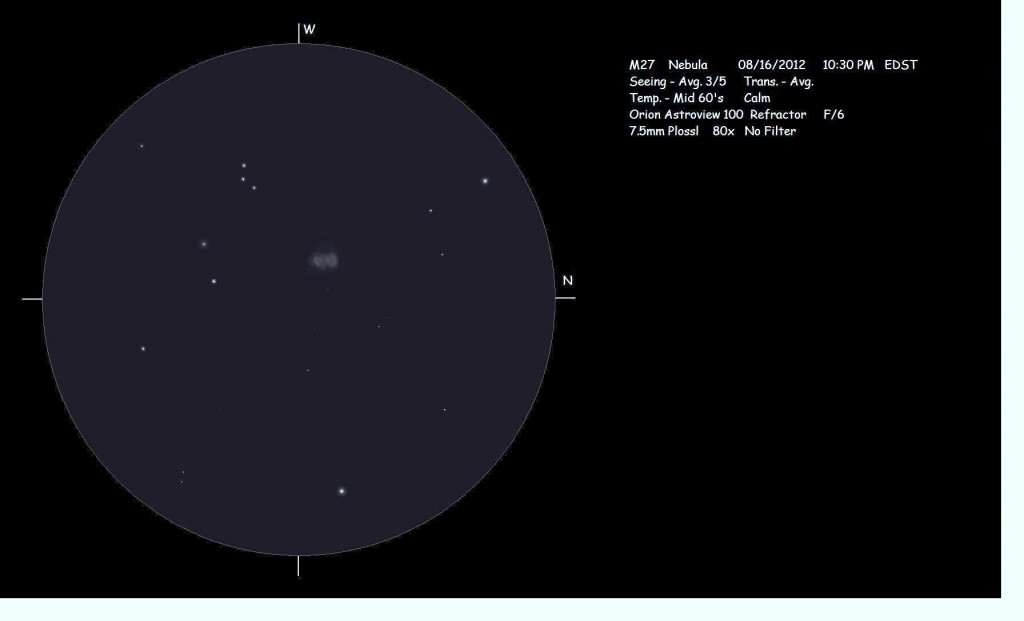
M27 Nebula
08/16/2012 Warren County NJ
Orion Astroview 100 Refractor F/6
7.5mm Plossl Eyepiece 80x
Sketched on a laptop computer while observing using MS Paint and MyPaint programs.
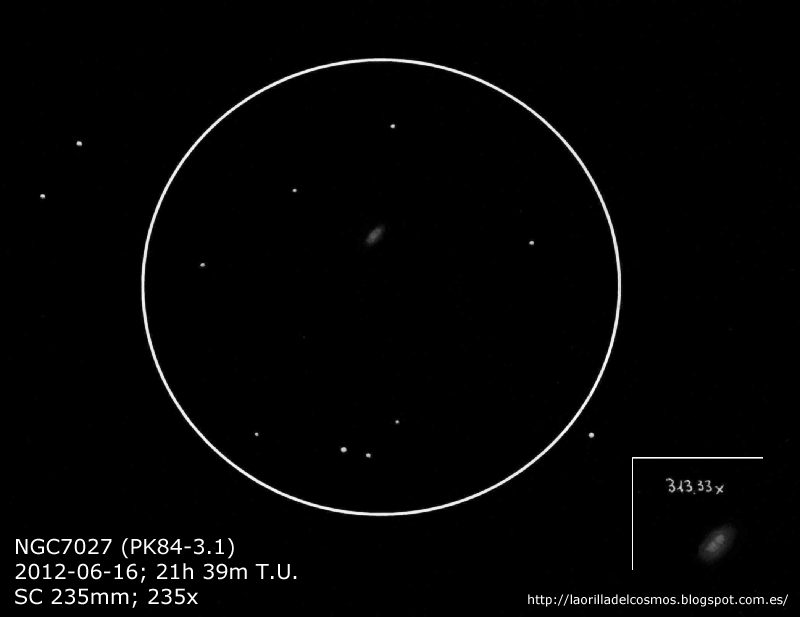
NGC7027 – PK84-3.1
Object Type: Planetary Nebula
Location: Barcelona – Spain
Located in a poor stellar field, I could see NGC7027 at 235x little, homogeneous bright and with an elongated shape, almost as a rectangle. But I could not perceive any halo around the bright planetary core. With the OIII filter I could see the nebula with more contrast, but no details.
With 313x, better adapted to the dark and using averted vision, I saw with satisfaction an evanescence halo around the core, which seems to split in half, like an ?8?.
Easy planetary to detect, but difficult to see details on it.
For more details of my observation you can visit my blog:
http://laorilladelcosmos.blogspot.com.es/2012/07/ngc7027-nebulosa-planetaria-en-cygnus.html
NGC7027 – Planetary Nebula in Cygnus
Date and Time: 2012-06-16, 21h 39m UT
Telescope: SC Celestron 235mm (9.25″) + CGEM Mount.
Eyepiece: Radian 10mm (235x) and Takahashi 7,5mm (313x)
Filter: OIII
White paper, HB2 graphite pencil, and scanned and inverted with Photoshop
Seeing: 3/5 (5 the best)
Transparency: Clear. Dark sky.
Location Constellation: Cygnus
Position: R.A. 21 h 07 min
Dec. +42° 14′
Thank you and best regards.
Oscar

Object Name: NGC6826, the Blinking Planetary
Object Type: Planetary Nebula
Location: Terneuzen, the Netherlands
Date: 21-06-2012Media: Photoshop, using several layers to make it smooth
NELM: 5.8
Seeing: average 6-7/10
This sketch was made using a 8 inch newtonian telescope on an HEQ-5 Pro from Skywatcher. The magnification I did used was around 400 times.
The central star was seen with ease and the ‘blinking’, where this planetary is known of, wasn’t seen with the magnification I used for the sketch. After several minutes of waiting for moments of good seeing, I noticed something strange. Something I haven’t seen in other sketches with the same aperture. It was a central bar, running from one end of the oval planetary to the other. Really nice to see a surprise like this.
After checking the internet, I’ve found some sketches and observations of some brighter parts of this planetary. At both end of the over planetary, there are some spots which are called FLIERS. Together with the brighter central spot and some ‘average’ seeing, it would probably merged together and be the reason for seeing a ‘bar’ instead of three brighter spots.
Luuk Haarmans
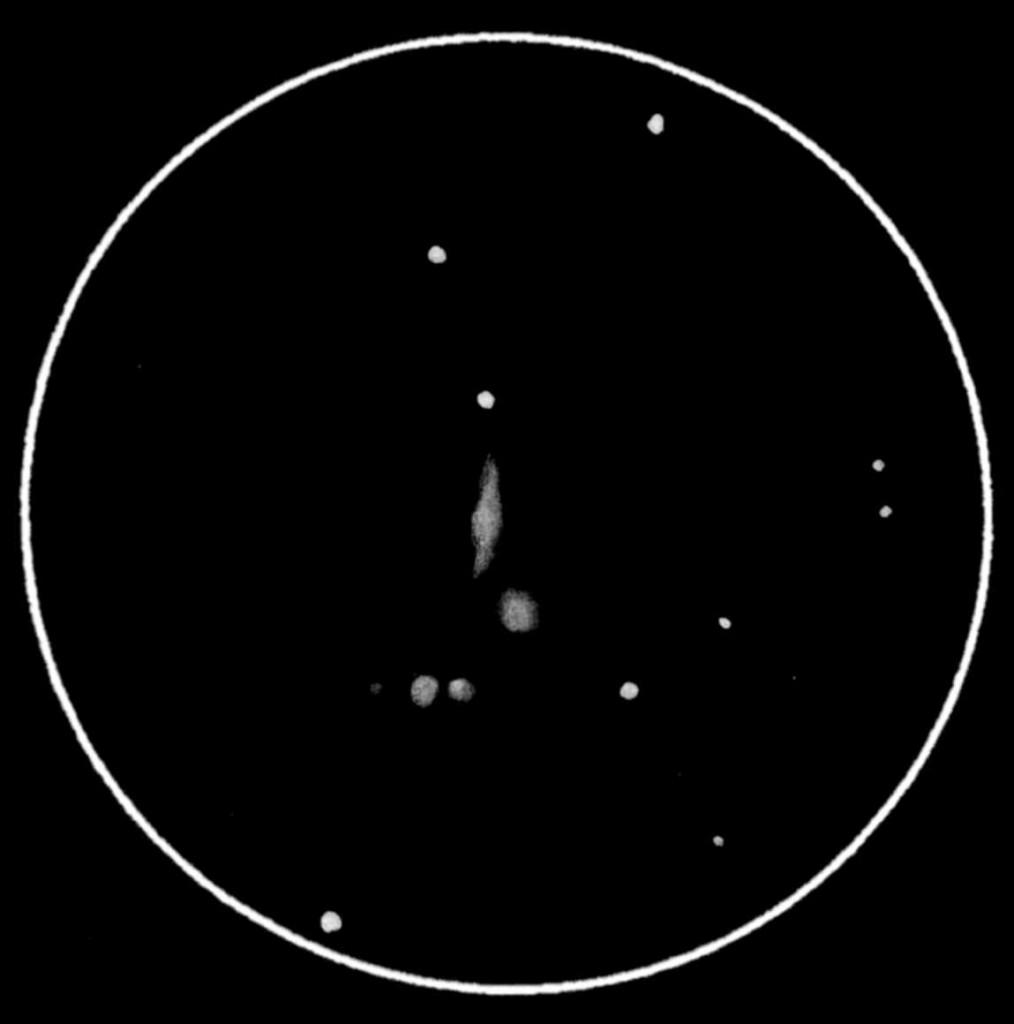
A bitterly cold night that saw the mercury drop to the lowest level I have ever known or recorded -16?C. I wanted to get an early observation in before Moon rise; my primary objective was to add another Hickson group to my list. This I did successfully with very appropriately HCG 28, I say appropriate as this was the 28th that I have observed and sketched. Located in Eridanus there are 4 faint members in the group although my sketch actually includes a 5th galaxy which isn’t a member and is depicted as a faint star. All members have PGC listing the faintest & smallest (d) member is Mag 18, so serious stuff! The commanding member is a nice edge on PGC 15136 running N-S, see my sketch here
Quite how I came to observe the next object I’m not quite sure? I may have noticed it close by on my planetarium software, not that it matters, it was an interesting and valuable observation. Again in Eridanus, NGC 1535 is a lovely planetary nebula, named ‘Cleopatra’s eye’ by Greg Crinklaw aka ‘The Skyhound’ a name that appears to have stuck and grown in popularity. I had observed this planetary back in 2010 with the old 350mm F5 and older first generation Watec camera, but this was my first visit with the 505mm mirror. It did show an improvement, despite the lower focal length employed on this occasion, I used a barlow lens previously to increase image scale and try and pull out more detail, I had failed to resolve a faint star on the very northern edge of the nebula, the central star was easy and steady as were internal annular ring structures rather like those in the ‘Eskimo’ nebula.
Here is my old sketch with the 350mm and here is the latest with the 505mm. At the time of writing I have asked Sue French if she would be so kind as to help assist me on finding the outer stars mag.
Happy days, Dale
Do you want to know more about my interest in astronomy? If so take a look at my Website: www.chippingdaleobservatory.com
Keep up to date with observations from Chippingdale Observatory by reading the Blog http://chippingdaleobservatory.com/blog/
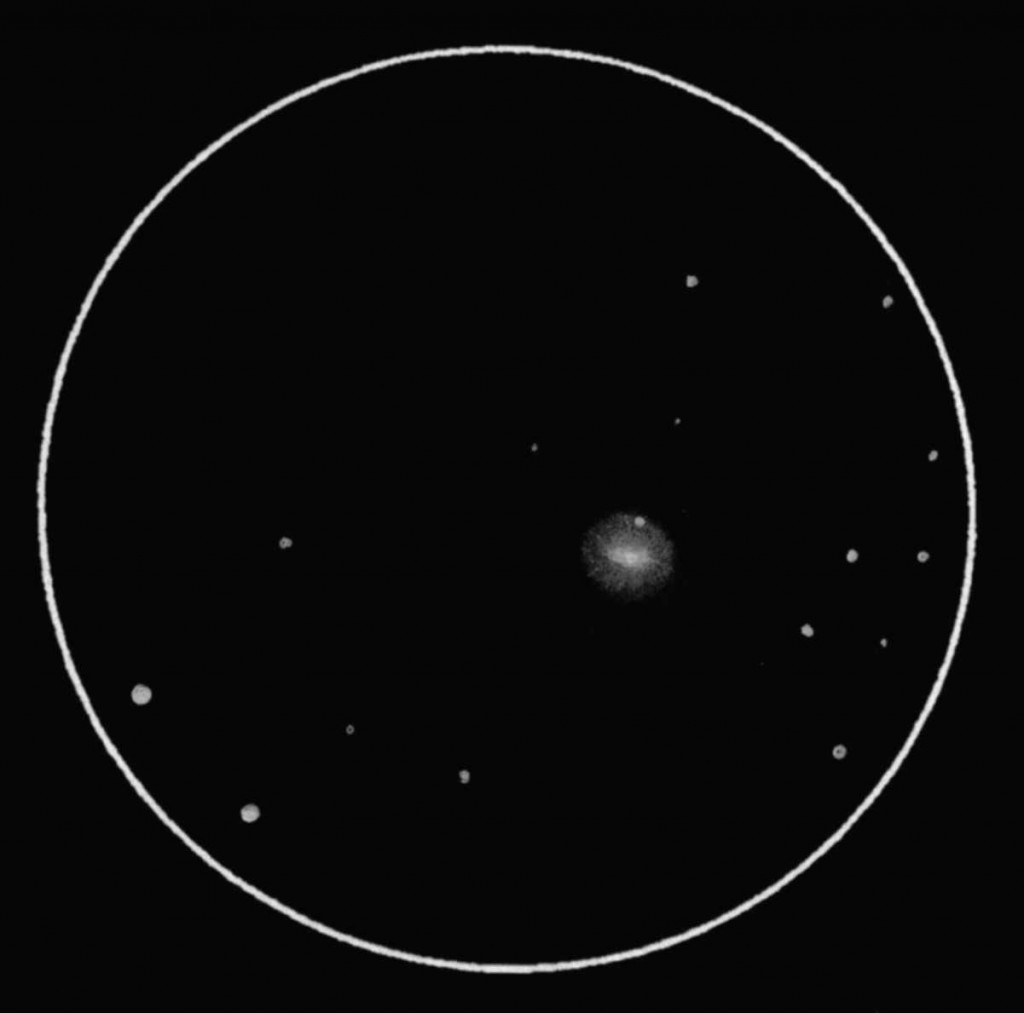
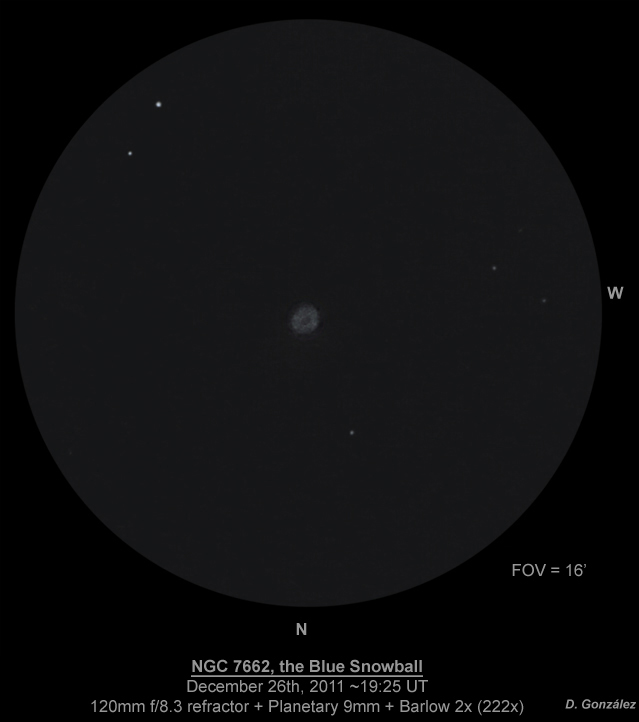
In a cold night last December I decided to spend some time observing NGC 7662, the Blue Snowball nebula in Andromeda, and the observation resulted in this sketch. At low powers it looks like a fuzzy star that shows a remarkable bluish color, which is probably the most evident color I’ve seen in a deep sky object. At high powers that color is lost, but the nebula starts to show a low contrast annular structure: it appeared to me as a slightly oval, thick ring with a small, not very dark central zone. The whole nebula had a “mottled” appearance, but no additional detail was visible.
Sketch: 2HB graphite pencil on white paper, scanned and processed with Photoshop CS3
Object Name: NGC 7662, the Blue Snowball
Object Type: Planetary nebula
Location: Asturias, Spain
Date: December 26th, 2011
Instrument: 120mm f/8.3 refractor + Planetary 9mm + barlow 2x (222x)
NELM: around 5.3, moderate light pollution
Clear skies!
Diego González
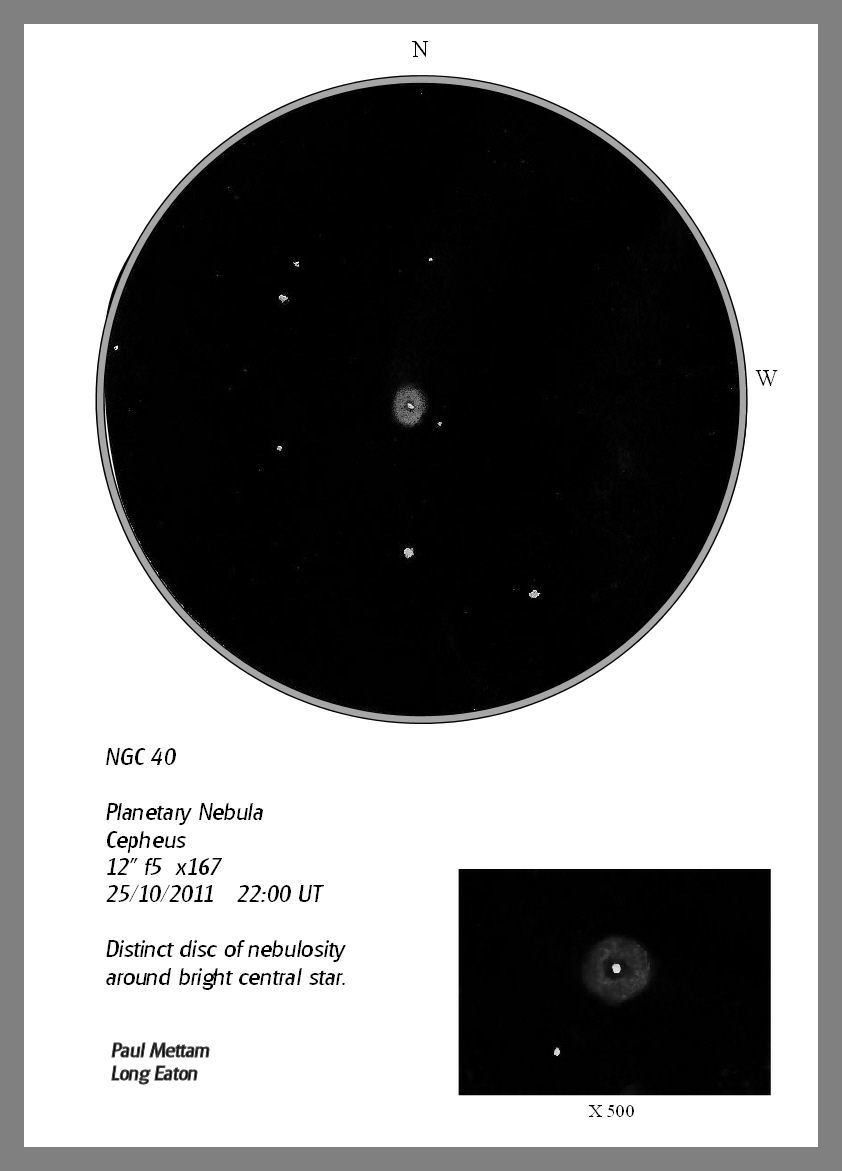
OBJECT NAME: NGC 40 The Bow-Tie Nebula
TYPE: Planetary Nebula
CONSTELLATION: Cepheus
LOCATION: Long Eaton, Derbyshire, England.
DATE: 25th October 2011
TELESCOPE: 12″ F5 Dobsonian
MEDIA: Pencil, white paper
NOTES: Prominent central star surrounded by slightly oval area of nebulosity. The nebula appears to fade slightly towards the star but this may just be a contrast effect.
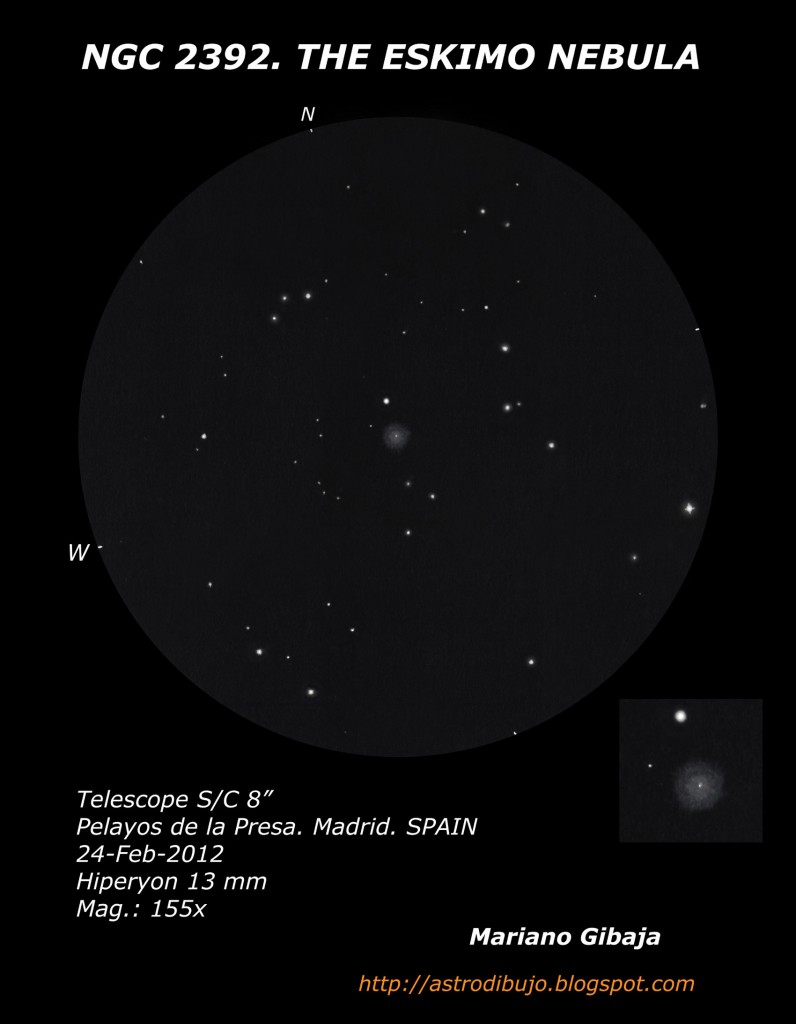
Object Name: NGC 2392
Location: RA: 07h 29m 10.8s; Dec: +20° 54′ 42”
Magnitude: 9.1
Constellation Gemini.
Type: Planetary Nebula.
Location: Pelayos de la Presa. Madrid. SPAIN
Date: February 24, 2012.
Time: 21:30 T.U.
Materials used: Graphite pencil on white paper. Inverted image and processed with Photoshop.
Telescope S/C 8″ Mount Cgt-5
Eyepiece., 13 mm Hyperion; Magnification: 155x.
Conditions: MALE: 5.3 (chart 4); Temp.: 3ºC, Humidity 27%.
More information on the sketch:
http://astrodibujo.blogspot.com
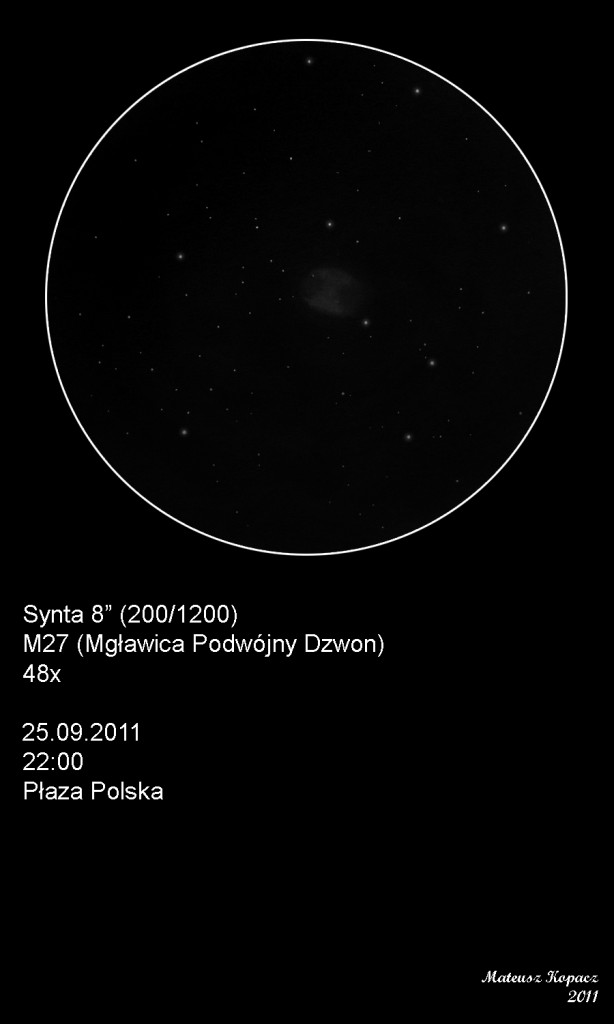
Object Name: M27 (Dumbbell Nebula)
Object Type: planetary nebula
Location: Płaza, Poland
Date: 25.09.2011
Media: graphite pencil, white paper, inverted
Dumbbell Nebula (M27) is a beautiful planetary nebula located in our galaxy. You can observing it at warm, but very short summer nights. When you’ll look at eyepiece, you’ll see the big nebula and a hundreds of stars, because this nebula is cut by one of our galaxy’s arm.